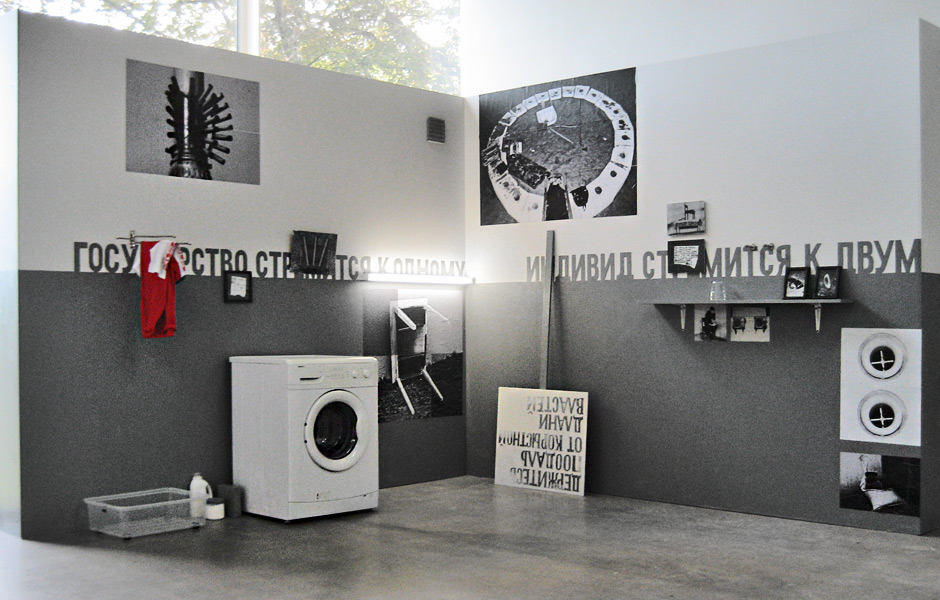Group exhibition:
ID: E11.8
Title:
A Complicated Relation
Date:
September 17 — November 20, 2011
Place:
Kalmar Konstmuseum, Kalmar, Sweden
Curator:
Martin Schibli
Artists:
«People’s Atlas of Public Space in Chisinau», «The Bombily Group», «Conceptual Art Centre Bukovje», Lado Darakhvelidze, Tatiana Fiodorova, Andrus Joonas, Nikita Kadan, «Kiss my Ba», Victoria Lomasko & Anton Nikolaev, Svätopluk Mikyta, Tanja Muravskaja, Ghenadie Popescu, Alexander Raevsky, «R.E.P.», Mykola Ridnyi, Stefan Rusu, Zurab Rtveliashvili, «San Donato group», Sergey Shabohin, «SOSka», Bo Söderlund, Giorgi Tabatadze, Marina Naprushkina and «The Office for Anti-propaganda», Alexander Verevkin, «Voina», Minna Öberg
Work:
Installation Practices of Subordination

Sergey Shabohin:
installation Practices of Subordination,
2011
installation Practices of Subordination,
2011
Explication:
The impetus for A Complicated Relation, part II is how many artists today are basing their work on given social and political contexts. The participating artists share a common desire to engage in — and involve their art in — a real social context. They want to contribute to change and to social development. These artists work with direct interaction on the street, publish journals with voices critical of the status quo, and undertake art projects that engage directly with society. In several cases the artists’ political commitments go hand in hand with their art. Some of the contributing artists are confronted periodically with actual threats and harassment.
We have chosen to present artists from Belarus, Estonia, Georgia, Moldavia, Slovakia, Slovenia, Russia, the Ukraine, and Belarus. Most of these countries are still seen as on the margins of an increasingly globalized European art world. From Russia we have several artists who work outside of Moscow in cities such as Kaliningrad, Samara, and Vladivostok. Many of the countries named above are societies in a state of transition where there does not yet exist an art world of any significance. That means that the artists must address the situation on their own without any real support from the art world; in fact, their work to a great extent consists in building up that world.
In countries undergoing social change, just as there is no defined art world, there is in some cases a lack of clearly defined social institutions. The paradox here is that these artists can sometimes have a greater impact with their interventions because it’s not possible simply to dismiss their work as pure “art” — because that would require a clear conception of the difference between what art is and what society’s institutions are.
On the other hand, this exhibition deals just as much with universal questions about the role of culture in a society’s progress. What can culture contribute to improving society and the process of democratization? This question is particularly important in all of the countries in global proximity to Sweden. Not least of these are places like Åland, where the younger segment of the population is leaving, or a region like Kalmar County, which is one of only three Swedish counties whose population is declining. How will Kalmar and Kalmar County survive into the future? How can culture contribute to countering this population decline? In many other countries, culture is employed as a future-forward strategy for winning economic and political
advantage in tomorrow’s Europe — specifically in order to survive. In this way, Kalmar finds itself in a similar situation.
We have chosen to present artists from Belarus, Estonia, Georgia, Moldavia, Slovakia, Slovenia, Russia, the Ukraine, and Belarus. Most of these countries are still seen as on the margins of an increasingly globalized European art world. From Russia we have several artists who work outside of Moscow in cities such as Kaliningrad, Samara, and Vladivostok. Many of the countries named above are societies in a state of transition where there does not yet exist an art world of any significance. That means that the artists must address the situation on their own without any real support from the art world; in fact, their work to a great extent consists in building up that world.
In countries undergoing social change, just as there is no defined art world, there is in some cases a lack of clearly defined social institutions. The paradox here is that these artists can sometimes have a greater impact with their interventions because it’s not possible simply to dismiss their work as pure “art” — because that would require a clear conception of the difference between what art is and what society’s institutions are.
On the other hand, this exhibition deals just as much with universal questions about the role of culture in a society’s progress. What can culture contribute to improving society and the process of democratization? This question is particularly important in all of the countries in global proximity to Sweden. Not least of these are places like Åland, where the younger segment of the population is leaving, or a region like Kalmar County, which is one of only three Swedish counties whose population is declining. How will Kalmar and Kalmar County survive into the future? How can culture contribute to countering this population decline? In many other countries, culture is employed as a future-forward strategy for winning economic and political
advantage in tomorrow’s Europe — specifically in order to survive. In this way, Kalmar finds itself in a similar situation.